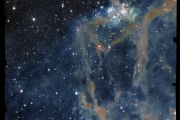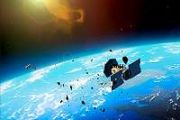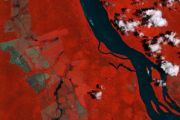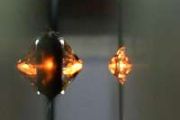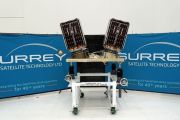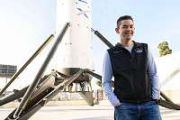
Copernical Team
Scientists utilize lunar soils to sustainably supply oxygen and fuels on moon in an unmanned manner
 Building up the lunar settlement is the ultimate aim of lunar exploitation since human's first step on the moon. Yet, limited fuel and oxygen supplies restrict human survival on the moon. Combining photovoltaic and electrocatalysis, the artificial production of hydrocarbon fuels along with oxygen using carbon dioxide and water as the feedstocks has been demonstrably feasible on the earth and kno
Building up the lunar settlement is the ultimate aim of lunar exploitation since human's first step on the moon. Yet, limited fuel and oxygen supplies restrict human survival on the moon. Combining photovoltaic and electrocatalysis, the artificial production of hydrocarbon fuels along with oxygen using carbon dioxide and water as the feedstocks has been demonstrably feasible on the earth and kno Spectral evolution of a dark asteroid surface after ten years of space weathering
 When asteroid 596 Scheila collided with an object in the asteroid belt between Mars and Jupiter in December 2010, a fresh layer of material was exposed on the asteroid surface . An international research team observed the spectrum from the asteroid approximately ten years later, to see how space weathering affects the surface over a genuine timescale. Within the uncertainty of the observations,
When asteroid 596 Scheila collided with an object in the asteroid belt between Mars and Jupiter in December 2010, a fresh layer of material was exposed on the asteroid surface . An international research team observed the spectrum from the asteroid approximately ten years later, to see how space weathering affects the surface over a genuine timescale. Within the uncertainty of the observations, ANU scientists use deep planetary scan to confirm Martian core
 Seismologists from The Australian National University (ANU) have developed a new method to scan the deep interior of planets in our solar system to confirm whether they have a core at the heart of their existence.
The scanning method, which works in a similar way to an ultrasound scan using sound waves to generate images of a patient's body, requires only a single seismometer on a planet's
Seismologists from The Australian National University (ANU) have developed a new method to scan the deep interior of planets in our solar system to confirm whether they have a core at the heart of their existence.
The scanning method, which works in a similar way to an ultrasound scan using sound waves to generate images of a patient's body, requires only a single seismometer on a planet's Lumpy Bumpy: Sols 3635-3636
 In today's plan, we got to exercise our combined APXS-MAHLI touch and go capability. Now that our days on Mars are starting a bit earlier thanks to Earth rising earlier in the morning sky, APXS gets a cooler time to operate on days we also drive.
So the APXS-MAHLI teams are back to being regular partners in exploration once again. Today's workspace was much like our last one, lumpy and bum
In today's plan, we got to exercise our combined APXS-MAHLI touch and go capability. Now that our days on Mars are starting a bit earlier thanks to Earth rising earlier in the morning sky, APXS gets a cooler time to operate on days we also drive.
So the APXS-MAHLI teams are back to being regular partners in exploration once again. Today's workspace was much like our last one, lumpy and bum Meteorite impact provides a glimpse beneath Mars' surface
 On 24 December 2021, NASA's InSight lander felt the ground shake. Its SEIS seismometer registered a marsquake of magnitude 4. Independently, a 150-metre diameter crater was photographed from orbit by the cameras of the Mars Reconnaissance Orbiter. The camera team was able to determine that it was formed on 24 December, and realised that this was the same day as the reported quake. When the two t
On 24 December 2021, NASA's InSight lander felt the ground shake. Its SEIS seismometer registered a marsquake of magnitude 4. Independently, a 150-metre diameter crater was photographed from orbit by the cameras of the Mars Reconnaissance Orbiter. The camera team was able to determine that it was formed on 24 December, and realised that this was the same day as the reported quake. When the two t NASA's Lunar Flashlight ready to search for the lunar ice
 Set for a November launch, the small satellite mission will use lasers to search for water ice inside the darkest craters at the Moon's South Pole. The Moon's poles offer a tantalizing opportunity for human explorers: There may be reservoirs of water ice there that could be purified as drinking water, converted into breathable oxygen, and used as fuel by astronauts. These reservoirs are inside p
Set for a November launch, the small satellite mission will use lasers to search for water ice inside the darkest craters at the Moon's South Pole. The Moon's poles offer a tantalizing opportunity for human explorers: There may be reservoirs of water ice there that could be purified as drinking water, converted into breathable oxygen, and used as fuel by astronauts. These reservoirs are inside p Starshade competition challenges students to block starlight for observing exoplanets
 AIP is organizing a competition for undergraduate students in the physical sciences to design a spaceborne starshade. The device will orbit Earth, blocking the light from a star and allowing ground-based telescopes to observe extra-solar planets.
Since the light coming from a star is likely billions of times brighter than the reflected light from an Earth-like exoplanet, obstructing the li
AIP is organizing a competition for undergraduate students in the physical sciences to design a spaceborne starshade. The device will orbit Earth, blocking the light from a star and allowing ground-based telescopes to observe extra-solar planets.
Since the light coming from a star is likely billions of times brighter than the reflected light from an Earth-like exoplanet, obstructing the li China launches experimental satellite into space
 China launched a Long March 2D carrier rocket on Saturday morning to transport an experimental satellite into space, according to China Aerospace Science and Technology Corp.
The State-owned space conglomerate said in a press release that the rocket blasted off at 9:01 am at the Jiuquan Satellite Launch Center in northwestern China and soon sent the Shiyan 20C, or Experiment 20C, into its
China launched a Long March 2D carrier rocket on Saturday morning to transport an experimental satellite into space, according to China Aerospace Science and Technology Corp.
The State-owned space conglomerate said in a press release that the rocket blasted off at 9:01 am at the Jiuquan Satellite Launch Center in northwestern China and soon sent the Shiyan 20C, or Experiment 20C, into its SpaceX California launch sends 53 more Starlink satellites into orbit
 SpaceX launched a Falcon 9 rocket carrying 53 more Starlink satellites into low Earth orbit on Thursday.
The flight lifted off from Vandenberg Space Force Base northwest of Los Angeles and headed southeast over the Pacific Ocean in its first minutes.
It was the 49th SpaceX mission of the year and roughly 75% of the flights launched Starlink satellites. Before the latest launch, S
SpaceX launched a Falcon 9 rocket carrying 53 more Starlink satellites into low Earth orbit on Thursday.
The flight lifted off from Vandenberg Space Force Base northwest of Los Angeles and headed southeast over the Pacific Ocean in its first minutes.
It was the 49th SpaceX mission of the year and roughly 75% of the flights launched Starlink satellites. Before the latest launch, S Beyond Gravity wins major contract from ULA for Amazon's Project Kuiper constellation launches
 In mid-March this year, Beyond Gravity (formerly RUAG Space) was awarded a contract to develop and deliver the dispenser system for Amazon's planned satellite constellation. Project Kuiper aims to provide affordable, high-speed broadband connections around the world.
Now, United Launch Alliance (ULA) has also awarded Beyond Gravity the contract to supply 38 payload fairings for its Vulcan
In mid-March this year, Beyond Gravity (formerly RUAG Space) was awarded a contract to develop and deliver the dispenser system for Amazon's planned satellite constellation. Project Kuiper aims to provide affordable, high-speed broadband connections around the world.
Now, United Launch Alliance (ULA) has also awarded Beyond Gravity the contract to supply 38 payload fairings for its Vulcan 

